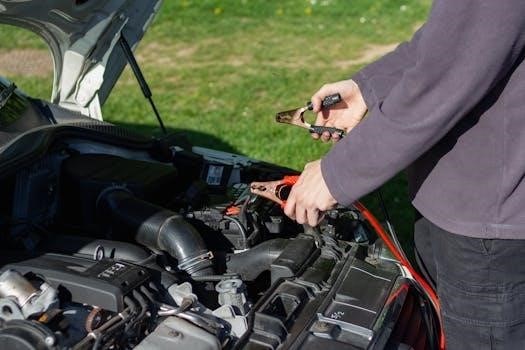Furrion TV manuals are essential guides for understanding your television’s features and functions. These manuals offer instructions for setup, operation, and troubleshooting, ensuring optimal performance. They provide critical information, including safety precautions and specifications.
Understanding the Importance of Furrion TV Manuals
Furrion TV manuals are crucial for maximizing your viewing experience and ensuring the longevity of your device. They provide detailed information on connecting various devices, understanding picture modes, and utilizing smart TV capabilities. These manuals are also vital for troubleshooting common issues such as “no signal” problems or power connectivity issues. Furthermore, manuals offer guidance on proper maintenance, care, and installation techniques to protect your investment, especially for outdoor models. Accessing and understanding your Furrion TV manual is key to fully enjoying its features.
Furrion TV Models and Manuals
Furrion offers various TV models, each with specific manuals. These manuals provide detailed information and specifications for your model, which is essential for proper use and maintenance.
Identifying Your Specific Furrion TV Model
Locating your specific Furrion TV model is crucial for accessing the correct manual. Furrion TVs come in different series, such as the Aurora outdoor models and various LED HD options. Look for the model number on the back of your TV, typically on a sticker. This number is essential for downloading the right user guide. Some manuals may specify the model in the title, like FDFD22A0A or FEHS24T8A. Knowing the exact model will provide the most accurate information.
Locating the Correct Manual for Your Furrion TV
Finding the correct manual for your Furrion TV can be done through several methods. Start by visiting the official Furrion website and navigating to their support or downloads section. Here, you can typically search for your specific model using the number identified earlier. Additionally, some retailers and RV manufacturers may also have copies of manuals available. Always ensure the manual matches your exact model number to avoid incorrect settings or operating instructions. Look for PDF files for easy access.
Powering Your Furrion TV
Furrion TVs are designed for versatile power options. They often support both 12V DC power for RV use and 110V AC power via adapters. Understanding these options ensures proper operation.
12V Power Options for Furrion TVs
Many Furrion TVs are specifically designed for RV and mobile use, featuring 12V DC power compatibility. This allows for direct connection to your RV’s electrical system, eliminating the need for an inverter when dry camping. Check your specific model’s manual for the correct wiring and fuse specifications to ensure safe and efficient operation. Using the correct 12V power source prevents damage and guarantees consistent performance while on the road or off-grid. These options are ideal for those seeking a truly mobile entertainment experience.
Using 110V Power Adapters with Furrion TVs
While many Furrion TVs support 12V power, they often include a 110V AC power adapter for use when connected to shore power. This adapter converts the standard household voltage to the required DC input for the TV. It is important to only use the adapter supplied with your Furrion TV or an authorized replacement to avoid damage. When using the 110V adapter, ensure it is properly connected and the power source is stable to prevent interruptions during usage. Always consult your manual for specific guidelines.
Furrion TV Features and Functions
Furrion TVs offer various features, including picture modes, smart capabilities, and app access. These functions enhance the viewing experience and provide user customization. Many models also support external device connections.
Navigating Picture Modes and Settings
Furrion TVs provide several picture modes, allowing users to customize the display based on viewing preferences and lighting conditions. These settings often include options for brightness, contrast, color, and sharpness. Users can select from preset modes like “vivid,” “standard,” or “movie,” or manually adjust settings for a personalized viewing experience. Understanding these options will help you optimize the picture quality for different content and environments, ensuring the best possible display from your Furrion TV.
Exploring Smart TV Capabilities and Apps
Many Furrion TVs come equipped with smart capabilities, allowing users to access streaming services and apps directly on the television. These smart features usually include built-in Wi-Fi, enabling connection to the internet. Explore pre-installed apps for streaming content from platforms like Netflix and other popular providers; The user manual should detail how to navigate the smart TV interface, install new apps, and manage your streaming subscriptions. This functionality enhances the entertainment experience and provides convenient access to a wide range of content.
Troubleshooting Common Furrion TV Issues
Furrion TVs, like all electronics, can encounter problems. This section addresses typical issues such as signal loss, power failures, and connection difficulties. Manuals often include steps to resolve such problems.
Addressing “No Signal” Problems
Encountering a “no signal” message on your Furrion TV is a common frustration. This issue often stems from incorrect input selection, a loose cable connection, or antenna problems. Ensure all cables are securely attached, the correct input source is selected, and the antenna or cable is working appropriately. Consulting your Furrion TV manual can offer tailored troubleshooting steps to resolve this.
Dealing with Power and Connectivity Issues
Power and connectivity problems with Furrion TVs can be disruptive. These might range from the TV not turning on to difficulties maintaining a stable signal. Check the power cord and ensure it’s properly plugged in and the outlet is functioning. For connectivity, verify all cable connections are secure and that the input source is correct. The user manual provides specific steps for troubleshooting these types of issues.
Advanced Furrion TV Settings
Exploring advanced settings allows users to optimize their Furrion TV experience. This includes connecting external audio devices and utilizing CEC for integrated device control, enhancing functionality and convenience.
Connecting External Audio Devices
Furrion TVs offer options to connect external audio devices, such as soundbars or amplifiers, for an enhanced listening experience. Typically, this involves using the audio out port on the TV. Connecting to an external amp or Furrion wall mount can greatly improve audio quality. Ensure the correct cables are used and the devices are properly configured for seamless sound output. Consult your manual for specific port locations and setup instructions. This setup allows for a more immersive audio experience.
Utilizing CEC for Device Control
Consumer Electronics Control (CEC) allows Furrion TVs to interact with other compatible devices connected via HDMI. This feature enables you to control multiple devices, like a DVD player or game console, using a single remote. When connected to a CEC compatible Furrion entertainment system, you can manage power and playback functions. Refer to your manual for instructions on enabling and configuring CEC. This simplifies your entertainment setup by reducing the number of remotes needed. Proper setup will ensure seamless operation.
Furrion TV Installation and Mounting
Proper installation is key for Furrion TVs. This section covers mounting techniques, ensuring secure placement. It also addresses connections to antennas and cable sources, optimizing signal reception for your entertainment.
Proper Mounting Techniques for Furrion TVs
When mounting your Furrion TV, ensure you select a secure and appropriate location, considering the TV’s weight and size. Use a compatible mount, following the manufacturer’s instructions precisely. For wall mounts, verify the wall can support the weight, and utilize appropriate hardware. Pay close attention to the mounting screws, ensuring they are correctly sized and tightened. Avoid mounting in areas exposed to direct sunlight or extreme temperatures. Consider professional installation if you are uncertain about any step of the process. Always ensure that all cables are properly connected after mounting.
Connecting to Antennas and Cable Sources
Connecting your Furrion TV to antenna or cable sources requires careful attention to the connections. For antennas, connect the coaxial cable securely to the TV’s antenna input. For cable connections, ensure the cable is properly connected to the cable input. Then, select the correct input source on your TV. Utilize the TV’s menu to scan for available channels after making all the necessary connections. Make sure the antenna is positioned correctly for optimal reception. Verify all connections are tight to avoid signal issues. Remember to refer to the specific instructions in your Furrion TV manual.
Furrion TV Maintenance and Care
Proper maintenance ensures longevity of your Furrion TV. Regular cleaning, avoiding direct sunlight and using weatherproof covers are essential. These practices preserve the TV’s condition. Refer to your manual for detailed cleaning instructions.
Maintaining Your Furrion TV
To maintain your Furrion TV, regularly clean the screen using a soft, dry cloth to remove dust and fingerprints. Avoid using harsh chemicals or abrasive materials, which can damage the screen. Ensure proper ventilation to prevent overheating. When not in use, especially for extended periods, unplug the TV. Check connections periodically and keep the area around the TV free from obstacles. These steps will help prolong the life and performance of your Furrion TV.
Using Weatherproof Covers for Outdoor Furrion TVs
Weatherproof covers are crucial for protecting outdoor Furrion TVs from the elements. These covers shield against rain, snow, dust, and UV rays, preventing damage and extending the lifespan of the television. When using a cover, ensure it fits snugly and securely around the TV; Remove the cover before use, and properly store it when the TV is in operation. Regularly inspect the cover for wear and tear, replacing it when needed to maintain optimal protection for your outdoor Furrion TV.
Where to Find Support for Furrion TVs
Furrion provides various support options, including online documents and direct customer service. Accessing these resources ensures you can quickly resolve any issues and fully enjoy your Furrion TV.
Accessing Furrion Support Documents
Furrion offers a range of support documents, including spec sheets and user manuals, available for download on their website. These documents provide detailed information about specific Furrion TV models and their features. Users can search by document title or paginate through all available resources. Utilizing the “copy link” function allows for easy sharing of specific documents via email or on a web page, ensuring access to accurate information. These resources are crucial for understanding your TV’s capabilities and troubleshooting any issues that may arise.
Contacting Furrion Customer Support
If you cannot find the answer to your question in the manual or support documents, Furrion provides avenues for contacting their customer support team. While specific contact details may vary, reaching out to their support channels can provide assistance with technical issues, warranty inquiries, and other product-related questions. The customer support team is available to help with any problems that you may have with your Furrion TV. They can provide guidance on setup, troubleshooting, and accessing specific features of your television.
Understanding your Furrion TV manual is crucial for optimal use. These manuals provide essential information for setup, features, and troubleshooting, ensuring a smooth viewing experience. They are key resources for owners.
Key Takeaways for Using Your Furrion TV
To maximize your Furrion TV experience, always refer to the user manual for specific model information. Understand the power options, whether 12V or 110V, for seamless operation. Explore picture modes to enhance viewing and utilize the smart features for added entertainment. Troubleshooting common issues, like “no signal,” is made easier with the manual’s guidance. Proper maintenance, including using weatherproof covers for outdoor models, will extend the life of your Furrion TV and ensure reliable performance. Remember to keep your manual handy for quick reference.
























